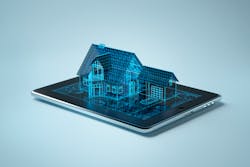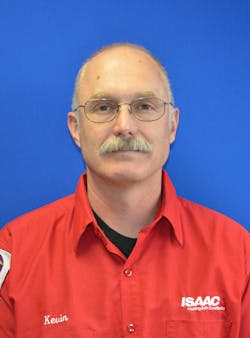Smart Technicians Integrating Internet of Things into Smart Homes
No question, homeowners in the U.S. are updating their residences to smart status—including smart HVACR systems. Smart homes rely on linked sensors and other appliances connected to the Internet of Things (IoT) that can be remotely monitored, controlled, or accessed. These connected devices can respond to homeowners' needs, such as enhanced heating and cooling comfort.
Demand in the U.S. for smart and connected thermostats is forecast to rise 18 percent per year through 2022, say researchers from The Freedonia Group. Its Industry Study 3659 predicts smart thermostats will retain a more than 70 percent share of the market over lower-tech connected units in 2022. Another research organization, Statista, says the average smart home revenue per active household in the Energy Management segment amounts to US$677.28 in 2019.
HVACR integration into IoT and smart homes will become the norm in the next 20 years, says Kevin Traut, director of Education and Training at Rochester, New York--based Isaac Heating & Air Conditioning. Traut says IoT and smart home technology is the future, and contractors can either embrace it or be left behind. "The potential for IoT applications for HVACR are unlimited--everything from air pressure sensors reminding a homeowner they need to be replaced, to remote preventive repairs and diagnostics for service companies."
Traut says his firm is preparing staffers on the new technology. "At Isaac Heating & Air, we are working closely with manufacturers to educate our sales team on the benefits of IoT.” He adds that his firm is training technicians and installers to work with smart equipment. "We have a dedicated training lab which is critical to conduct 'real world' set up and service training."
To get on the road to the future, Traut urges HVACR firms to do their homework. "They should match the system to the right application and client, as well as educate and train their technicians."
Training for technicians is a key part of ecobee’s smart home strategy. The firm is a Toronto, Ontario-based producer of smart thermostats. The company conducts a 2.5-hour, NATE-approved training program that ecobee’s contractor-partners complete, says Adam Welton, senior marketing manager. The training covers sales and installation of the firm's products. "We’ve been running this program for 4 years with very strong success. In fact, we have classes running almost every week of the year. We have many partners across every region of the continental U.S. that have gone on to use ecobee as a core part of their connected strategy," Welton says.
Richie Drew, an owner of One Hour Heating & Air Conditioning in Myrtle Beach, South Carolina, says his firm prepares its technicians to adopt and use IoT and smart homes technology. “One Hour provides specific product training on systems from Google Nest, Sensi, Honeywell, and other companies.” One Hour staffers are trained regularly on existing tech as well as the latest tech, Drew says.
Drew explains that staffers test out systems whenever and wherever they can. "We install new technologies in our own homes and offices to become familiar with operating these systems on a daily basis. We have technicians take them home and install them and use them, as well.
"We test them and try to come up with every possible scenario for practical applications. We study the systems' strengths and weaknesses."
There's a lot of collaboration, Drew adds. "We sit down in our tech meetings and discuss the products and the pluses and minuses. We try to think of every question a homeowner may ask and how we can use that specific product to solve the problem. We are always looking at the latest products and vetting them internally."
David Giannetto, COO of WorkWave, a firm that provides technology infrastructure for service companies, including HVACR and mechanical, says HVACR contractors need to look at how closely their service offering aligns to smart homes. "If it’s too far out from their wheelhouse, and if they don’t feel comfortable with it culturally, then they are going to have a hard time adopting all this.
"If they start to see their service offering as not just mechanical equipment, the way HVACR contractors think, but they see the increasing influence of actual IoT technology over that mechanical equipment, then those are the firms that are going to be much more adaptable to smart home trends in the future." Giannetto says.
The smartphone is becoming the centerpiece of how a homeowner will interact with their smart home, says Scott Harkins, VP and general manager, Connected Home at Resideo. Resideo is a global provider of critical comfort and security solutions, mainly in residential environments. The firm also distributes low-voltage electronic and security products.
Harkins notes that there are several other smart home control points beyond the smartphone. "Voice, while imperfect, has become a leading control point for the smart home. Cameras with analytics can create experiences with the need for a specific interface. And finally, consumer testing continues to support that customers want a physical interface as a 'just-in-case' solution. We can’t downplay emerging technology like gesture control as a potential control point." Harkins says the homeowner will have options. "The smartphone is likely to be a primary control point, but certainly not the only control."
The smart thermostat is often the basis for IoT in the home as it offers core functionalities, serves as a platform for connecting other devices, and enables smartphone integration, says James McPhail, CEO of Zen Ecosystems. The company provides energy management solutions for commercial buildings and homes.
The smart thermostat offers versatility, McPhail says. "Users, contractors, and manufacturers can easily package other technology onto a smart thermostat, such as security cameras, door locks, window locks, sound detection, and lighting control." McPhail says we'll see fewer thermostats with buttons, since those functions are more automated and digitized onto people's smart devices.
Subhead: What Smart Homeowners Can Expect in the Future IoT apps and smart home systems are already delivering energy savings to homeowners, according to Richie Drew at One Hour Heating & Air Conditioning.. And the benefits will continue to grow, he adds.
One advantage of remote programming and geo-fencing (automatic home/away recognition based on the homeowner's mobile device) is that it makes energy-saving features easy to use. "This technology,” says Drew, “will get smarter and smarter with each evolution of the products on the market today. I think the biggest breakthroughs are residential monitoring that can alert a homeowner when there is a problem with the system before it causes a system failure. Your system could actually alert the repair person at the same time and schedule a tech to come perform the service or maintenance to prevent the breakdown."
Drew says the possibilities are endless as to how intelligent these devices can be. "The learning thermostats out there today learn the homeowners’ habits, i.e., when they are home or asleep, therefore, they can adjust temperature settings to save energy. These learning systems will continue to get smarter and smarter."
Kim Komando also sees smart homes getting smarter. Komando is the host of the Kim Komando Show on the radio and via podcasts. The program is a source for news on all things digital, including equipment trends, security threats, tips and tricks.
"Instead of separate ecosystems for smart home tech, we will see far more cross-connectivity where every device, appliance, and system in your home is seamlessly connected in real-time, and working together," says Komando. "Smart homes of the future will be equipped with diagnostic sensors that know if there’s a problem before you do, and that includes HVACR systems."
It’s not just about more efficient systems, Komando adds. "Smart thermostats made by Google Nest and ecobee are already common, along with sensors that can adjust the climate in specific rooms or zones on set schedules. That type of on-demand climate control that can be customized down to the person is a smart home feature we’ll likely see."
Preventive maintenance gets a boost in future systems, Komando says. "And you won’t just get a push notification that your air filter needs to be changed. Some HVACR companies have hardware and software solutions that can monitor and service your system remotely."
Because HVACR technology is evolving, that also means service technicians will have to evolve, too, Komando says. "They’ll still need the foundational skills that have been key to this career for decades, but thanks to the Internet of Things, that training is increasingly going to involve working with sophisticated, Internet-connected and automated computers at the heart of future HVACR systems. In turn, it’ll be that much easier to troubleshoot any issues that arise."
Komando continues. "As time goes on, 5G’s speed and potential for connectivity at a level that’s never been seen before will open the doors for smart cities and even smarter homes." (Editor's note: 5G is the fifth-generation cellular network technology).
And it doesn't stop there. "Your residence will increasingly be controlled through apps on your smartphone and with your voice” explains Komando. “Mesh router systems will become more common to better handle the growing number of devices connected to your Wi-Fi network, while expanding the reach to all parts of your home."
Komando offers one caution regarding HVACR systems: "We just have to make sure that HVACR training includes network security. That’s an emerging issue, no doubt about it."
A truly smart home must offer something more than novel gadgets, says Resideo's Scott Harkins. "It must protect, prevent, and react to changes in conditions–both inside the house, such as aging appliances, and outside, such as extreme weather conditions. A failing furnace in the middle of a polar vortex? A flooded basement after returning home from vacation? Those are problems that a homeowner just shouldn't have to deal with in the 21st century." Harkins says that today, most homeowners are not checking and maintaining the crucial appliances in their home until it’s too late (and they wind up incurring costly replacement fees).
Harkins says that as smart home technology grows and develops, it will be up to the HVACR professional to persuade the homeowner on the value and benefits of living in a smart home.
On the subject of failing appliances and systems, vendors are offering tools that aid in maintenance and failure monitoring, says Kirill Kniazev, marketing director at Motili. His firm’s asset tagging program collects and manages data such as HVACR unit age, efficiency and condition at the property and apartment portfolio level. “This data can be used, in the future, to predict HVACR system failures with accuracy before they happen,” Kniazev says.
“If an HVACR unit is able to identify an anomaly and send an alert to a property manager or directly to a preferred technician, before it breaks down, this allows property owners and managers to schedule maintenance in advance, ahead of peak HVACR season,” Kniazev says. This means less hassle looking for contractors, lower labor rates, and happy homeowners and tenants, he adds.
About the Author
Michael Keating
Michael Keating is a freelance writer specializing in industrial and technology-related topics and trends.


